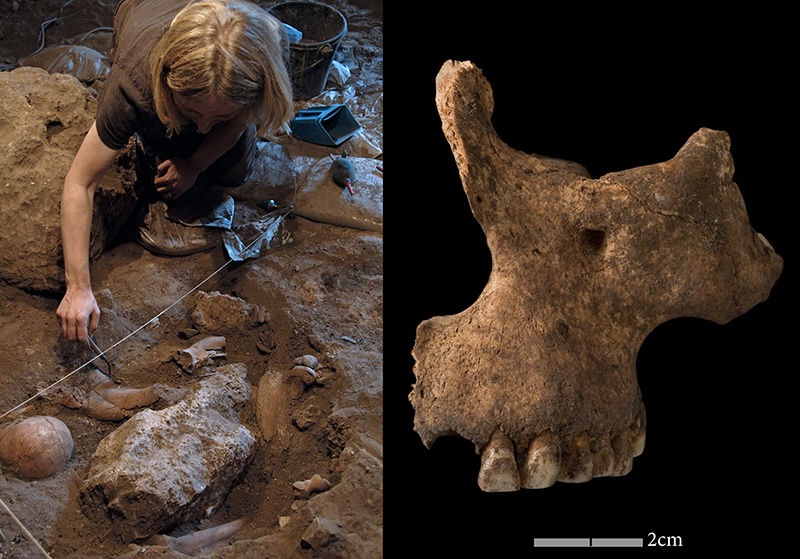Oldest Human DNA from Africa Reveals Clues About a Mysterious Ancient Culture

Burials from a cave in Morocco have yielded the oldest human DNA evidence yet from Africa, offering new insight into Stone Age migrations.
The DNA samples come from one of the most ancient cemeteries in the world, the Grotte des Pigeons, near the village of Taforalt in northeast Morocco.
Beginning around 15,000 years ago, a culture of hunter-gatherers buried their dead with animal horns and other adornments inside this cave. Though burials were found as recently as 2006, archaeologists have been excavating the cave since the 1940s. [Image Gallery: Our Closest Human Ancestor]
The name 20th-century researchers gave to this culture —the Iberomaurusians—reflects the theory that the people who lived in this corner of North Africa were closely connected to Europe, and perhaps migrated across the Mediterranean by boat or a land bridge from the Iberian Peninsula or Sicily. Iberomaurusian sites have been found across the Maghreb, the area between the Atlas Mountains that span Morocco, Algeria and Tunisia, and the Mediterranean Sea. Some archaeologists had argued that small blades from sites like the Grotte des Pigeonsresembled the stone tools of the Gravettian culture, which was widespread across southern Europe during the Upper Paleolithic (which lasted from about 50,000 to 10,000 years ago). Today, North Africans have a large amount of European DNA.
But the new DNA evidence tells a different story about the origins of the Iberomaurusians. During recent excavations led by the University of Oxford at the Grotte des Pigeons, archaeologists saved the inner-ear petrous bones, a good source for ancient DNA. Researchers at the Max Planck Institute for the Science of Human History, in Jena, Germany, extracted ancient mitochondrial DNA, which is passed on only from mothers to their children, from seven individuals, as well as nuclear DNA, which is inherited from both parents, from five of the skeletons.
"Due to challenging conditions for DNA preservation, relatively few ancient genomes have been recovered from Africa, and none of them so far predate the introduction of agriculture in North Africa," Marieke van de Loosdrecht, an archaeogeneticist at the Max Planck Institute for the Science of Human History, said in a statement.
Contrary to the theory that Europeans from Sicily or the Iberian Peninsula were buried at Grotte des Pigeons, the analysis revealed no genetic link to southern Europe. Instead, the results, which were reported March 15 in the journal Science, showed that about two-thirds of the Iberomaurusian DNA matched closely with that of ancient Natufians, a later culture that existed in the Middle East, which suggests the Grotte des Pigeons people and the Natufians shared common ancestors from North Africa or the Middle East.
Get the world’s most fascinating discoveries delivered straight to your inbox.
About one-third of the Iberomaurusian DNA resembled the DNA of sub-Saharan Africans, which was perhaps inherited from more ancient ancestors or was contributed by contemporary Stone Age migrants, according to an accompanying news article in Science. The findings offer new evidence of early contacts between North Africa and the Near East, and regions south of the Sahara Desert, thought to be a major barrier to migration.
Ancient DNA studies have exploded in Europe over the past couple of decades, covering a record of human history stretching back 40,000 years. Many of the labs where scientists study ancient DNA are located in Europe, and researchers have access to a wealth of well-preserved remains.
The study of ancient African genomes has been much sparser. The researchers of the new study wrote that African sites tend to have more challenging conditions for DNA preservation; warmer temperatures tend to accelerate DNA decay. It was only in 2015 that researchers published the first African ancient genome, from 4,500-year-old human remains found in Ethiopia. Last year, scientists reported findings on ancient DNA from as early as 8,100 years ago, from human remains from southern and East Africa.
The researchers wrote that further DNA studies on additional Iberomaurusian sites will be"critical"to testing whether the evidence from the Grotte des Pigeons is representative of the Iberomaurusian gene pool.
Original article on Live Science.



